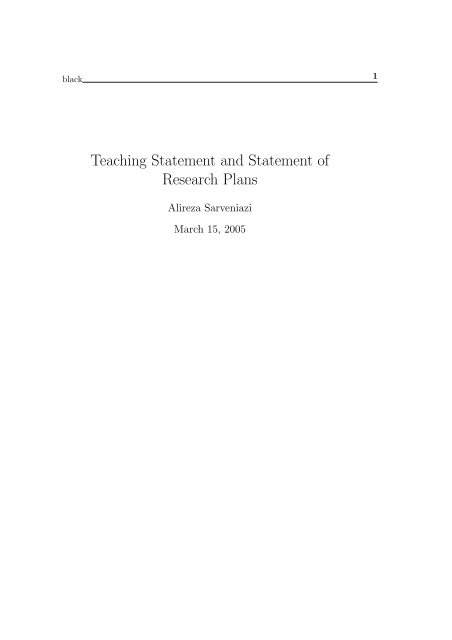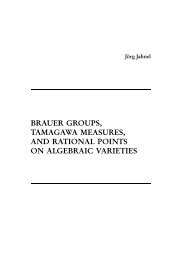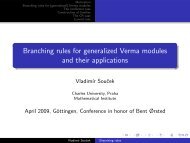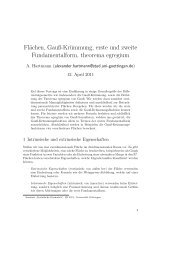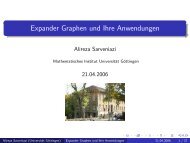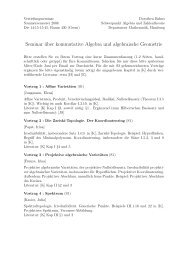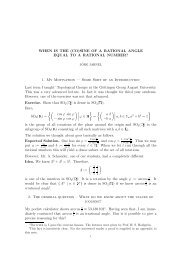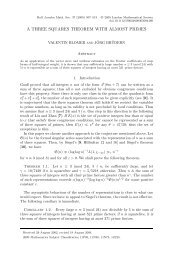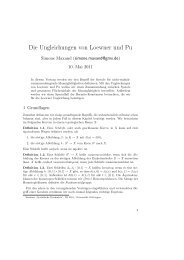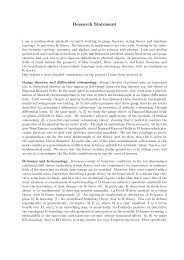Teaching Statement and Statement of Research Plans - GWDG
Teaching Statement and Statement of Research Plans - GWDG
Teaching Statement and Statement of Research Plans - GWDG
You also want an ePaper? Increase the reach of your titles
YUMPU automatically turns print PDFs into web optimized ePapers that Google loves.
lack 1<br />
<strong>Teaching</strong> <strong>Statement</strong> <strong>and</strong> <strong>Statement</strong> <strong>of</strong><br />
<strong>Research</strong> <strong>Plans</strong><br />
Alireza Sarveniazi<br />
March 15, 2005
2 Index<br />
<strong>Teaching</strong> <strong>Statement</strong>:<br />
I enjoy teaching mathematics <strong>and</strong> gain great satisfaction from seeing my<br />
students learning different ways <strong>of</strong> thinking about mathematical notions <strong>and</strong><br />
problems. My prefered method <strong>of</strong> teaching is to allow students the time so<br />
they can attain the fundamental underst<strong>and</strong>ing <strong>of</strong> a particular subject. This<br />
process <strong>of</strong> learning is completed by stressing the essential elements <strong>of</strong> mathematics.<br />
To underst<strong>and</strong> Mathematics at the university level, one must develop<br />
the ability to think abstractly <strong>and</strong> also geometrically. It is also my belief that<br />
my students should recognize abstract algebraic notions <strong>and</strong> geomemetrical<br />
objects. The teaching philosophy that I adhere to is based on the theory, <strong>of</strong><br />
how students want to learn mathematics. Students develop their mathematical<br />
dexterity best by building relationships between new definitions <strong>and</strong> their<br />
capacity <strong>of</strong> abstract underst<strong>and</strong>ing <strong>and</strong> geometrical imagination. Students<br />
must be active participants in the learning process by trying to design nontrivial<br />
questions. Further, they must be prepared to apply their knowledge<br />
in order to solve mathematical problems.<br />
I try to give in my lectures many examples <strong>and</strong> analogies that make the <strong>of</strong>ten<br />
abstract concepts more clear. The most important aspect <strong>of</strong> my teaching is<br />
to provide the core abilities mixed with new concepts that allow student to<br />
develop their problem solving skills. I belive that students can be provided<br />
with a deeper underst<strong>and</strong>ing <strong>of</strong> mathematics, in particular under graduate<br />
level <strong>of</strong> mathematics, if they know applications <strong>of</strong> certain contexts in the real<br />
world, such as computer science, communication networks or even in physics.<br />
<strong>Teaching</strong> Interest:<br />
-Calculus<br />
-Number theory (elementary course)<br />
-Galois theory <strong>and</strong> Finite fields<br />
-The first <strong>and</strong> second course in Algebra<br />
-The first <strong>and</strong> second course in Analysis<br />
-Differential Geometry (elementary course)<br />
-Complex functions <strong>and</strong> Analysis<br />
-General Topology<br />
-Discrete Mathematics<br />
-The first <strong>and</strong> second course in Graph theory<br />
-Seminars for graduate students
Index 3<br />
Introduction<br />
In this short article, I describe briefly the projects that I am currently working<br />
on, <strong>and</strong> the projects that I’d like to work on in the near future. My<br />
primary research interest is in automorphic representations <strong>and</strong> arithmetic<br />
number theory. More specifically, I would like to use Bruhat-Tits Buildings<br />
based on non-archimedian local fields <strong>and</strong> associated automorphic forms <strong>and</strong><br />
representations to solve certain problems in Number Theory, Combinatorics,<br />
<strong>and</strong> Computer Science.<br />
Most <strong>of</strong> my research is centered around Ramanujan (graphs) hypergraphs <strong>and</strong><br />
associated Zeta <strong>and</strong> (L)-functions. Before giving a description <strong>of</strong> projects, I<br />
give an informal overview <strong>of</strong> my construction <strong>of</strong> Ramanujan hypergraphs.<br />
Ramanujan hypergraphs<br />
In my thesis (see : http://www.uni-math.gwdg.de/asarveni/index1.html or<br />
enclosed paper) I studied Ramanujan regular hypergraphs, generalizing the<br />
definition <strong>of</strong> Ramanujan graphs introduced by A.Lubotzky, R.Philips, P. Sarnak<br />
[13], [14]. There are closely related papers by A.Lubotzky B.Samuels <strong>and</strong><br />
U.Vishne [15] ,<strong>and</strong> a beautiful simple construction by W. Lie [12]. The main<br />
difference between these <strong>and</strong> my construction is that I am using a very special<br />
kind <strong>of</strong> algebra, namely the skew polynomial ring F q d{τ} <strong>and</strong> its quotient<br />
field F q d(τ), as the main tools throughout my thesis to arrive at an explicit<br />
construction <strong>of</strong> Ramanujan hypergraphs. These skew polynomial rings also<br />
are very useful in other branches <strong>of</strong> Mathematics, such as Drinfeld Modules,<br />
or Invariant theory. Though the explicit construction is beautiful, it<br />
is not possible to underst<strong>and</strong> this construction without technical arguments<br />
<strong>and</strong> a deep knowledge <strong>of</strong> the geometric nature <strong>of</strong> Buildings <strong>of</strong> type Ãd−1. I<br />
would like to illustrate the rich connections <strong>of</strong> the notion <strong>of</strong> Ramanujan hypergraph<br />
with several parts <strong>of</strong> mathematics, for example with the theory <strong>of</strong><br />
Bruhat -Tits Buildings, with representation theory, with combinatorics, <strong>and</strong><br />
with ‘non-commutative algebraic-geometry’ as the natural search for zeros <strong>of</strong><br />
skew polynomials over finite fields. This viewpoint shows that my construction<br />
is more practical for applications to Computer Science <strong>and</strong> is the most<br />
natural extension <strong>of</strong> the notion <strong>of</strong> Ramanujan graph. Apart from the use <strong>of</strong><br />
the arithmetic skew polynomial ring as specified above, the other important<br />
difference is in making use <strong>of</strong> Lafforgue’s <strong>and</strong> Arthur-Clozel’s results in the<br />
representation theory <strong>of</strong> automorphic forms. Below we quickly review my<br />
explicit construction (for pro<strong>of</strong>s <strong>and</strong> further details see [21]). The explicit<br />
construction shows that the Cayley graph <strong>of</strong> a certain complicated group
4 Index<br />
(with respect to a certain set <strong>of</strong> generators), is the same as the Cayley graph<br />
<strong>of</strong> a well-known group PGL(d) over a finite field, with respect to a set <strong>of</strong><br />
easily-described generators.<br />
Property (τ), Selberg Property, Ramanujan-Peterson conjecture<br />
It is well known that every arithmetic lattice Γ (at least over fields <strong>of</strong> characteristic<br />
0 <strong>and</strong> conjecturally always) has the Selberg property. If in addition<br />
Γ has the congruence subgroup property, then Γ has also (τ). This leads to<br />
following conjecture: see [16] for more detail.<br />
Conjecture 1. Let Γ be a lattice in a semisiple group.<br />
congruence subgroup property if <strong>and</strong> only if Γ has (τ).<br />
Then Γ has the<br />
There is a close relationship between the congruence subgroup property, the<br />
Selberg property <strong>and</strong> the Ramanujan-Peterson conjecture. One <strong>of</strong> my main<br />
goals is to study these relationships more deeply with the viewpoint <strong>of</strong> obtaining<br />
more information related to the above conjecture. I have some ideas<br />
how to generalise the known case to the higher dimensional case <strong>and</strong> I am<br />
interested in arithmetic groups having property (τ) over a division ring <strong>and</strong><br />
I want to consider the effect <strong>of</strong> the (τ) property on the lifting <strong>of</strong> the representations<br />
to the similar corresponding linear groups such as GL or SL under<br />
the Langl<strong>and</strong>s corespondence.<br />
Group action on the set <strong>of</strong> galleries <strong>of</strong> a Bruhat-Tits Building<br />
Let D be a division algebra over a function field K i.e, a finite extension<br />
<strong>of</strong> F q (t) with dim D K = d 2 , <strong>and</strong> π = (π) a place which is unramified in D,<br />
i.e,<br />
D π := D ⊗ K K π<br />
∼ = Md (K π )<br />
<strong>and</strong> π is an irreducible polynomial in OsupsetF q [t] .<br />
Let M 0 <strong>and</strong> M π 0 be the set <strong>of</strong> maximal orders in D <strong>and</strong> D π respectively. We<br />
can see first that,M π 0 can be interprated as the set <strong>of</strong> vertices <strong>of</strong> a Bruhat-<br />
Tits building X π ∗ associated to PGL d (K π ). We can also consider another<br />
Bruhat-Tits building X (global case) with M 0 as the set <strong>of</strong> vertices. Let R<br />
be a fix maximal order in D. Now consider the set:<br />
The unit group Γ (1)<br />
R<br />
X 0 (R) π = {M ∈ M 0 | M v = R v for all v ≠ π}<br />
R is equal to the number <strong>of</strong> orbits <strong>of</strong> Γ (1)<br />
R<br />
:= R ⊗ O[ 1<br />
π ]× acts on X 0 (R) π <strong>and</strong> the class number <strong>of</strong><br />
under this action. For any oder S
Index 5<br />
<strong>of</strong> level π n in D, we denote its nth associated unit group with<br />
U (n)<br />
S<br />
:= (S ⊗ O[ 1 π ])× .<br />
I will generalise the work <strong>of</strong> three “Son” (Rosson, H J. <strong>and</strong> Ellison,B J.<br />
<strong>and</strong> Wilson,J B.), TREES, HECKE OPERATORS, AND QUADRATIC<br />
FORMS, http://darkwing.uoregon.edu/ jwilson7/math/PrePrintTree.pdf, 2001<br />
as follows:<br />
I will show there is a group action <strong>of</strong> U (n)<br />
S<br />
:= (S ⊗O[ 1 π ])× on the set <strong>of</strong> galeries<br />
<strong>of</strong> length n on the Bruhat-Tits building X ∗ which gives us the class number<br />
<strong>of</strong> S as the number <strong>of</strong> orbits <strong>of</strong> U (n)<br />
S<br />
:= (S ⊗ O[ 1 π ])× under this action. Also I<br />
will study Br<strong>and</strong>t matrices <strong>and</strong> show that there is some recursive formulas to<br />
compute these matrices <strong>and</strong> also to compute the number <strong>of</strong> solutions arised<br />
from reduced norm equation.<br />
Bruhat-Tits Building <strong>and</strong> the Zeta functions <strong>of</strong> nilpotent groups<br />
Using the combinatorial geometry <strong>of</strong> the Bruhat-Tits building for SL(d,Q p ),<br />
C. Voll introduced a new method to compute local normal zeta functions <strong>of</strong><br />
nilpotent groups (see [24]). This motivates me to study more the nature <strong>of</strong><br />
the Bruhat-Tits Building arising in my thesis for the same situation but over<br />
the local function field instead <strong>of</strong> Q p in a more technical point <strong>of</strong> view.<br />
Zeta <strong>and</strong> (L)-functions <strong>of</strong> finite graphs <strong>and</strong> finite regular-hypergraphs<br />
Ihara obtained, for a discrete co-compact <strong>and</strong> torsion-free subgroup Γ <strong>of</strong><br />
SL(2,Q d ) <strong>and</strong> the associated Bruhat-Tits tree (X . ), a zeta function <strong>of</strong> the<br />
finite graph Γ\(X ∗ ). Ihara, using the theory <strong>of</strong> automorphic forms, has presented<br />
successfully his beautiful discovery: the identity <strong>of</strong> the zeta function<br />
<strong>of</strong> the finite graph Γ\(X ∗ ) <strong>and</strong> the zeta function <strong>of</strong> certain Shimura curve<br />
S Γ reduced modulo a prime p (see [10], [9]). One <strong>of</strong> the main ingredients<br />
required, to generalise the above connection to higher-rank reductive groups<br />
G over a global field K, is to obtain a suitable definition for the zeta function<br />
<strong>of</strong> a finite hypergraph (= a finite quotient <strong>of</strong> the Bruhat-Tits building)<br />
associated to the G(K ν ) for a place ν.<br />
There are some ideas by C.Ballantine <strong>and</strong> W. Li <strong>and</strong> A.Deitamr (based on<br />
Selberg’s trace formula) in the higher dimensional case. But it seems that a<br />
thorough structured theory could be worked out. In my recent work [22], I<br />
have three main goals:<br />
1) Thanks to Garl<strong>and</strong>’s work [6] I define a Zeta function related to the closed
6 Index<br />
galleries <strong>of</strong> finite quotient (hypergraph) S, i.e., Z S (ρ, u) with associated representation<br />
ρ, (which for dimension = 2 matches with the usual Zeta function<br />
for a finite graph). Actually I use the notion <strong>of</strong> Bruhat-Tits Building based<br />
on a Tits-system plus the orientation given in Garl<strong>and</strong>’s paper–where the<br />
oriented simplicial has been given in the language <strong>of</strong> parahoric subgroups<br />
<strong>and</strong> co-chains which I need for my further study.<br />
2) For a finite dimensional (usually unitary) representation ρ : Γ −→ GL(V )<br />
where Γ is the fundamental group π 1 (X) <strong>of</strong> a given finite graph X, we can<br />
define<br />
Z(X, ρ, u) = ∏<br />
1<br />
det (Id − ρ([C])u l([C]) )<br />
[C]∈P<br />
(<br />
∑ ∞ )<br />
= exp Nm(X) ρ um m<br />
i=1<br />
where P is the set <strong>of</strong> all primitive classes <strong>of</strong> primitiv closed paths, <strong>and</strong> l the<br />
length <strong>of</strong> any such class. For the trivial representation, Nm Id (X) = card{ the<br />
set <strong>of</strong> all primitive closed paths <strong>of</strong> length m}. Ihara has given a closed formula<br />
for this Zeta function <strong>and</strong> Bass [3] has generalized this formula further. It<br />
is <strong>of</strong> great interest to me to try to do the same for the Zeta function <strong>of</strong> a<br />
hypergraph as in 1) above. In this case we have more adjacency operators,<br />
<strong>and</strong> the main problem is again to control the oriented simplices so that these<br />
adjacencies occur in the denominator. Also we can use (in the situation <strong>of</strong><br />
1) above) the other definition <strong>of</strong> Bruhat-Tits building related to simplicial<br />
complexes (i.e., using parahoric subgroups ) <strong>and</strong> for example, for such simple<br />
fundamental domains as in my explicit construction mentioned above, I define<br />
a Zeta function <strong>and</strong> obtain a formula similar to Ihara’s formula.<br />
3) Let Γ ⊂ SL(2, K) be a discrete, cocompact <strong>and</strong> torsion-free subgroup<br />
where K is a local field ≠ R <strong>and</strong> ≠ C, <strong>and</strong> let X Γ := Γ\(X . ), where X .<br />
is the (q + 1)-regular tree associated to SL(2, K). Further let ρ Γ be the<br />
corresponding representation <strong>of</strong> the associated Iwahori-Hecke algebra (see<br />
[7] <strong>and</strong> [8]). Then we have<br />
det L(W, S, ρ Γ , u)<br />
det L(W 1 , S, ρ Γ , u) det L(W 2 , S, ρ Γ , u) = Z(X Γ, u)<br />
which is related to the Tits-system (G, B, N, S) where<br />
G := SL(2, K)<br />
( ) O<br />
×<br />
O<br />
B :=<br />
M O ×
Index 7<br />
where O is the ring <strong>of</strong> integers <strong>of</strong> K, M its maximal ideal with the generator<br />
π.<br />
N := the group <strong>of</strong> monomial matrices<br />
S :=<br />
{<br />
s 1 :=<br />
( 0 −1<br />
1 0<br />
)<br />
, s 2 :=<br />
( 0 −<br />
1<br />
π<br />
π 0<br />
)}<br />
W := The Weyl group<br />
N/B ∩ N<br />
W i := the subgroup generated by s i<br />
Recall the following definition <strong>of</strong> Gyoja’s for the L-function <strong>of</strong> any Coxeter<br />
system (W, S) with respect to a finite dimensional representation φ :<br />
H q (W, s) −→ End(V ) (where H q (W, s) is the associated Iwahori-Hecke algebra<br />
with the generator set {e w } (for all these definitions see [4].))<br />
L(W, S, φ, u) := ∑ w∈W<br />
φ(e w )u l(w)<br />
In the above l is the length function defined on W . L(W i , S, φ, u) could be<br />
defined similarly by replacing W with W i . My main goal is to generalise this<br />
beautiful formula ( as mentioned in [8]) to the higher dimensional case based<br />
on definitions discussed in 1) <strong>and</strong> 2) above. With such a suitable definition<br />
<strong>of</strong> the Zeta function Z( ˜X, u) for the finite regular hypergraph ˜X : Γ\X . , X .<br />
being the Bruhat-Tits building associated to GL(d, K ν ), we must have:<br />
Z( ˜X, u) = ∏ L(W I , S, ρ Γ , u) (−1)|I|<br />
I⊂S<br />
The pro<strong>of</strong> <strong>of</strong> the above formula <strong>and</strong> the definitions it needs are being written<br />
up in detail <strong>and</strong> will appear as a paper in arXiv soon.<br />
Some interesting research Projects for the near future<br />
In [18] the so-called discrete quantum Fourier-transforms <strong>of</strong> the number states<br />
i.e. the superpositions:<br />
q−1<br />
∑<br />
|θ p >:= q −1/2<br />
n=0<br />
exp( 2iπpn )|n ><br />
q<br />
I believe that such states live in Ramanujan graphs, especially those associated<br />
to finite groups Z/NZ for suitable N, but the question is :<br />
How can one in general interpret such superpositions as vertices <strong>of</strong> suitable<br />
Ramanujan graphs? How can one use the deep results from representation<br />
theory <strong>and</strong> arithmetical group theory lying behind the Ramanujan property<br />
to the study <strong>of</strong> Cyclotomy or in general to associated physical phenomena?<br />
I also have ideas to generalise these connections even to higher dimensions.
8 Index<br />
References<br />
[1] L. , Lafforgue. Chtocas de drinfeld et ramanujan-petersson. Asterisque,<br />
(243), 1997.<br />
[2] J. Arthur <strong>and</strong> L. Clozel. Simple Algebras, Base Change, <strong>and</strong> the Advanced<br />
Theory <strong>of</strong> the Trace Formula. Princton University Press, 1989.<br />
[3] Hyman Bass. The ihara -selberg zeta function <strong>of</strong> a tree lattice. Internat.<br />
J.Math. (1992) 717-797.<br />
[4] N. Bourbaki. Lie groups <strong>and</strong> Lie algebras. Chapter 4 − 6.<br />
[5] K. Brown. Buildings. Springer-Verlag, New York, 1988.<br />
[6] H. Garl<strong>and</strong>. p-adic curvature <strong>and</strong> cohomology <strong>of</strong> discrete subgroups <strong>of</strong><br />
p-adic groups. Ann. <strong>of</strong> Math. 97, 375 − 423.<br />
[7] Ki-I. Hashimoto. Zeta functions <strong>of</strong> finite graphs <strong>and</strong> represetations <strong>of</strong><br />
p-adic groups. Adv. Stud. Pure Math., vol. 15, 1991, pp. 171 − 210.<br />
[8] W.J. H<strong>of</strong>fman. Remarks on the zeta function <strong>of</strong> a graph.<br />
www.math.lsu.edu/ preprint/2002/jwh2002b.pdf.<br />
[9] Y. Ihara. Discrete subgroups <strong>of</strong> PL(2, k p ). c. Sympos. Pure Math. IX,<br />
Boulder, Colo, 1965. 272 − 278.<br />
[10] Y. Ihara. Algebraic curves mode p <strong>and</strong> arithmetic groups. Proc. Sympos.<br />
Pure Math. IX, Boulder,Colo, pp.265 − 271, 1965.<br />
[11] S. Lang. Algebra. Addison Wessly, 1965.<br />
[12] W. Li. Ramanujan hypergraphs, preprint. Preprint, 2003.<br />
[13] A. Lubotzky, R. Philips, <strong>and</strong> P. Sarnak. Ramanujan conjectures <strong>and</strong><br />
explicit construction <strong>of</strong> exp<strong>and</strong>ers. Proc. Symp. on Theo. <strong>of</strong> Camp. Sci<br />
(STOC), 86, 240-246, 1988.<br />
[14] A. Lubotzky, R. Philips, <strong>and</strong> P. Sarnak. Ramanujan graphs. Combinatorica<br />
8,261 − 277, 1988.<br />
[15] A. Lubotzky, B. Samuels, <strong>and</strong> U. Vishne. Ramanujan complex <strong>of</strong> type<br />
à n . http://arxiv.org/pdf/math.CO/0406217, 2004.<br />
[16] A. Lubotzky <strong>and</strong> A. Zuk. On property (τ). priprint, 2003.
Index 9<br />
[17] Ronan. M. Buildings: Main ideas <strong>and</strong> applications, I,II. Bulletin <strong>of</strong> the<br />
London Mathematical Society 24,1 − 57, 97 − 126, 1992.<br />
[18] M. Planat <strong>and</strong> H.C. Rosu. Cyclotomy <strong>and</strong> Ramanujan sums in quantum<br />
phase loking. [PDF] arXiv:quant-ph/0304101 v2 17 Jun 2003.<br />
[19] H J. Rosson, B J. Ellison, <strong>and</strong> J B. Wilson. Trees, hecke operators,<br />
<strong>and</strong> quadratic forms. http://darkwing.uoregon.edu/ jwilson7/math/PrePrintTree.pdf,<br />
2001.<br />
[20] P Sarnak. Some Applications <strong>of</strong> Modular Forms. Cambridge Tracts in<br />
Mathematics 99, Cambridge University Press,, 1990.<br />
[21] A. Sarveniazi. P.h.d thesis. Goettingen University publication, 2003.<br />
[22] A. Sarveniazi. Zeta <strong>and</strong> L functions on regular hypergraphs, preprint.<br />
2003.<br />
[23] J. Serre. Trees. Springer-Verlag, Berlin-Heidelberg-New York, 1980.<br />
[24] C. Voll. Zeta functions <strong>of</strong> groups <strong>and</strong> enumeration in Bruhat-Tits building.<br />
Ph.D. thesis, university <strong>of</strong> Cambridge, 2002.


